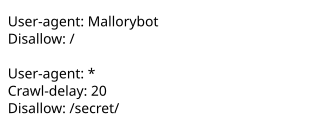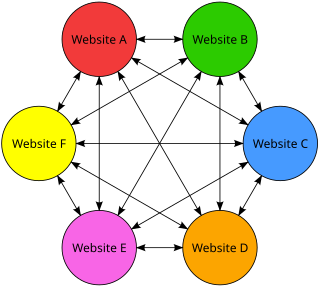Related Research Articles
Meta elements are tags used in HTML and XHTML documents to provide structured metadata about a Web page. They are part of a web page's head section. Multiple Meta elements with different attributes can be used on the same page. Meta elements can be used to specify page description, keywords and any other metadata not provided through the other head elements and attributes.
Spamdexing is the deliberate manipulation of search engine indexes. It involves a number of methods, such as link building and repeating unrelated phrases, to manipulate the relevance or prominence of resources indexed in a manner inconsistent with the purpose of the indexing system.

robots.txt is the filename used for implementing the Robots Exclusion Protocol, a standard used by websites to indicate to visiting web crawlers and other web robots which portions of the website they are allowed to visit.
Search engine optimization (SEO) is the process of improving the quality and quantity of website traffic to a website or a web page from search engines. SEO targets unpaid traffic rather than direct traffic or paid traffic. Unpaid traffic may originate from different kinds of searches, including image search, video search, academic search, news search, and industry-specific vertical search engines.

On the World Wide Web, a link farm is any group of websites that all hyperlink to other sites in the group for the purpose of increasing SEO rankings. In graph theoretic terms, a link farm is a clique. Although some link farms can be created by hand, most are created through automated programs and services. A link farm is a form of spamming the index of a web search engine. Other link exchange systems are designed to allow individual websites to selectively exchange links with other relevant websites, and are not considered a form of spamdexing.

Googlebot is the web crawler software used by Google that collects documents from the web to build a searchable index for the Google Search engine. This name is actually used to refer to two different types of web crawlers: a desktop crawler and a mobile crawler.
Cloaking is a search engine optimization (SEO) technique in which the content presented to the search engine spider is different from that presented to the user's browser. This is done by delivering content based on the IP addresses or the User-Agent HTTP header of the user requesting the page. When a user is identified as a search engine spider, a server-side script delivers a different version of the web page, one that contains content not present on the visible page, or that is present but not searchable. The purpose of cloaking is sometimes to deceive search engines so they display the page when it would not otherwise be displayed. However, it can also be a functional technique for informing search engines of content they would not otherwise be able to locate because it is embedded in non-textual containers, such as video or certain Adobe Flash components. Since 2006, better methods of accessibility, including progressive enhancement, have been available, so cloaking is no longer necessary for regular SEO.

A metasearch engine is an online information retrieval tool that uses the data of a web search engine to produce its own results. Metasearch engines take input from a user and immediately query search engines for results. Sufficient data is gathered, ranked, and presented to the users.
URL redirection, also called URL forwarding, is a World Wide Web technique for making a web page available under more than one URL address. When a web browser attempts to open a URL that has been redirected, a page with a different URL is opened. Similarly, domain redirection or domain forwarding is when all pages in a URL domain are redirected to a different domain, as when wikipedia.com and wikipedia.net are automatically redirected to wikipedia.org.
Google AdSense is a program run by Google through which website publishers in the Google Network of content sites serve text, images, video, or interactive media advertisements that are targeted to the site content and audience. These advertisements are administered, sorted, and maintained by Google. They can generate revenue on either a per-click or per-impression basis. Google beta-tested a cost-per-action service, but discontinued it in October 2008 in favor of a DoubleClick offering. In Q1 2014, Google earned US$3.4 billion, or 22% of total revenue, through Google AdSense. In 2021, more than 38 million websites used AdSense. It is a participant in the AdChoices program, so AdSense ads typically include the triangle-shaped AdChoices icon. This program also operates on HTTP cookies.
Search engine marketing (SEM) is a form of Internet marketing that involves the promotion of websites by increasing their visibility in search engine results pages (SERPs) primarily through paid advertising. SEM may incorporate search engine optimization (SEO), which adjusts or rewrites website content and site architecture to achieve a higher ranking in search engine results pages to enhance pay per click (PPC) listings and increase the Call to action (CTA) on the website.
In blogging, a ping is an XML-RPC-based push mechanism by which a weblog notifies a server that its content has been updated. An XML-RPC signal is sent from the weblog to one or more Ping servers, as specified by originating weblog), to notify a list of their "Services" of new content on the weblog.
A scraper site is a website that copies content from other websites using web scraping. The content is then mirrored with the goal of creating revenue, usually through advertising and sometimes by selling user data.
nofollow is a setting on a web page hyperlink that directs search engines not to use the link for page ranking calculations. It is specified in the page as a type of link relation; that is: <a rel="nofollow" ...>. Because search engines often calculate a site's importance according to the number of hyperlinks from other sites, the nofollow setting allows website authors to indicate that the presence of a link is not an endorsement of the target site's importance.

A search engine is a software system that provides hyperlinks to web pages and other relevant information on the Web in response to a user's query. The user inputs a query within a web browser or a mobile app, and the search results are often a list of hyperlinks, accompanied by textual summaries and images. Users also have the option of limiting the search to a specific type of results, such as images, videos, or news.

In geomarketing and internet marketing, geotargeting is the method of delivering different content to visitors based on their geolocation. This includes country, region/state, city, metro code/zip code, organization, IP address, ISP, or other criteria. A common usage of geotargeting is found in online advertising, as well as internet television with sites such as iPlayer and Hulu. In these circumstances, content is often restricted to users geolocated in specific countries; this approach serves as a means of implementing digital rights management. Use of proxy servers and virtual private networks may give a false location.

On the World Wide Web, HTTP 301 is the HTTP response status code for 301 Moved Permanently. It is used for permanent redirecting, meaning that links or records returning this response should be updated. The new URL should be provided in the Location field, included with the response. The 301 redirect is considered a best practice for upgrading users from HTTP to HTTPS.

Bing Webmaster Tools is a free service as part of Microsoft's Bing search engine which allows webmasters to add their websites to the Bing index crawler, see their site's performance in Bing and a lot more. The service also offers tools for webmasters to troubleshoot the crawling and indexing of their website, submission of new URLs, Sitemap creation, submission and ping tools, website statistics, consolidation of content submission, and new content and community resources.
In the field of search engine optimization (SEO), link building describes actions aimed at increasing the number and quality of inbound links to a webpage with the goal of increasing the search engine rankings of that page or website. Briefly, link building is the process of establishing relevant hyperlinks to a website from external sites. Link building can increase the number of high-quality links pointing to a website, in turn increasing the likelihood of the website ranking highly in search engine results. Link building is also a proven marketing tactic for increasing brand awareness.
White fonting is the practice of inserting hidden keywords into the body of an electronic document, in order to influence the actions of a search program reviewing that document. The name white fonting comes from the practice of adding keywords to a webpage, using a white font on a white background, in an effort to hide the additional keywords from sight.
References
- ↑ "Google Groups". www.google.com. Retrieved 2018-04-24.
- ↑ "Webmaster Guidelines - Search Console Help". support.google.com. Retrieved 2018-04-24.
- ↑ Kurtov, Michael. "Doorway into Weak Beauty. On the Cultural and Political Value of Spamdexing".
{{cite journal}}: Cite journal requires|journal=(help)